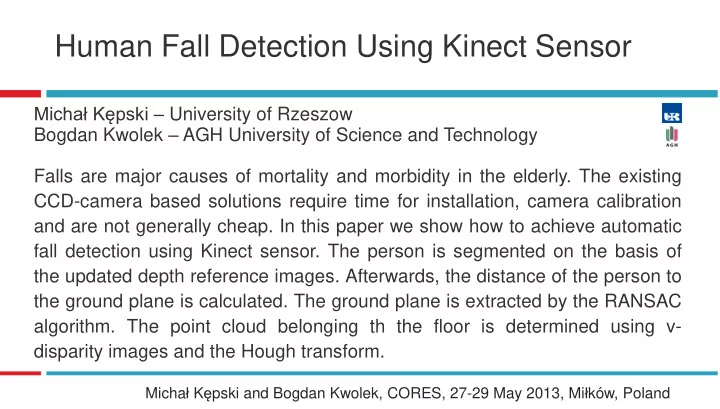

Human Fall Detection Using Kinect Sensor Michał Kępski – University of Rzeszow Bogdan Kwolek – AGH University of Science and Technology Falls are major causes of mortality and morbidity in the elderly. The existing CCD-camera based solutions require time for installation, camera calibration and are not generally cheap. In this paper we show how to achieve automatic fall detection using Kinect sensor. The person is segmented on the basis of the updated depth reference images. Afterwards, the distance of the person to the ground plane is calculated. The ground plane is extracted by the RANSAC algorithm. The point cloud belonging th the floor is determined using v- disparity images and the Hough transform. Micha ł K ę pski and Bogdan Kwolek, CORES, 27-29 May 2013, Mi ł ków, Poland
Agenda ▫ Fall detection problem ▫ Approaches to fall detection ▫ Motivation and Background ▫ Our approach ▫ Fall detection algorithm ▫ Experimental Results ▫ Summary Micha ł K ę pski and Bogdan Kwolek, CORES, 27-29 May 2013, Mi ł ków, Poland
Fall detection ▫ Fall Detection isolates falls from activities of daily living (ADLs). ▫ The goal of fall detection technology is to detect the fall occurrence as soon as possible and generate an alert. Micha ł K ę pski and Bogdan Kwolek, CORES, 27-29 May 2013, Mi ł ków, Poland
Fall detection: facts ▫ Falls are major causes of mortality and morbidity in the elderly. ▫ From 20 to 30 percent of those who have fallen have medium to severe injuries. ▫ Half of those, who have fallen can not get up without help. Micha ł K ę pski and Bogdan Kwolek, CORES, 27-29 May 2013, Mi ł ków, Poland
Fall detection: primary challanges ▫ Reach high performance of fall detection ▫ Reduce number of false alarms ▫ Generate alarm as quickly as possible ▫ Preserve user privacy Micha ł K ę pski and Bogdan Kwolek, CORES, 27-29 May 2013, Mi ł ków, Poland
Fall detection: approaches Since falls are usually characterized by larger acceleration compared with ADL, the existing solutions for fall detection mainly use accelerometers and gyroscopes. ▫ Several ADLs have similar kinematic motion patterns with real falls (false alarms). ▫ Inadequate to be worn during the sleep. Micha ł K ę pski and Bogdan Kwolek, CORES, 27-29 May 2013, Mi ł ków, Poland
Fall detection: approaches Many attempts have been made to detect falls using vision system, consisting of single camera, multiple cameras or omnidirectional cameras. ▫ CCD-camera based solutions require time for installation, camera calibration and they are not generally cheap. ▫ Can not work in nightlight or low light conditions. Micha ł K ę pski and Bogdan Kwolek, CORES, 27-29 May 2013, Mi ł ków, Poland
Motivation and Background ▫ Humans may not have consistent color and texture but have to occupy and integrated region in space. ▫ Software for the Kinect sensor has been developed - allows human computer interaction by skeleton tracking. ▫ Not applicable for fall detection: Micha ł K ę pski and Bogdan Kwolek, CORES, 27-29 May 2013, Mi ł ków, Poland
Our approach ▫ Use Microsoft Kinect Device ▫ Utilize depth maps only ▫ Preserve user privacy ▫ Invariant to light conditions Micha ł K ę pski and Bogdan Kwolek, CORES, 27-29 May 2013, Mi ł ków, Poland
Fall detection algorithm Algorithm Online phase: Offline phase: □ Person detection □ Calculation of background reference image □ Background actualization □ Determining the ground plane □ Calculation of the distance between the person’s center of gravity to ground plane □ Detection of the fall occurrence Micha ł K ę pski and Bogdan Kwolek, CORES, 27-29 May 2013, Mi ł ków, Poland
Fall detection algorithm: offline V- disparity: V-disparity [Labayrade, 2002] image calculation for plane detection: v-disparity 3D RANSAC Hough Transform a, b, c, d I v H ( I ) aX bY cZ d c c c D 2 2 2 a b c RANSAC: Ground plane detection The offline phase of the algorithm utilizes RANSAC [Fischler, 1981] for plane coefficients calculation. Micha ł K ę pski and Bogdan Kwolek, CORES, 27-29 May 2013, Mi ł ków, Poland
Fall detection algorithm: online Extraction of the Object of Interest: Center of gravity: n n X Y i i Z Z i 1 i 1 c ( x , y ) ( , ) k k X ( x x x ) Y ( y y y ) n n k k o k k o f f Micha ł K ę pski and Bogdan Kwolek, CORES, 27-29 May 2013, Mi ł ków, Poland
Fall detection algorithm: online Background reference image actualization: Temporal median filter is utilized for background actualization. The background estimate is defined to be the median at each pixel location of all the frames in the buffer . Micha ł K ę pski and Bogdan Kwolek, CORES, 27-29 May 2013, Mi ł ków, Poland
Experimental Results Four volunteers with age over 26 years attended in experiments and tests of our algorithm. A dataset of normal activities (walking sitting down, etc.) has been composed in order to determine the threshold value. Intentional falls were performed in home towards a carpet. Each individual performed three types of falls three times. All intentional falls were detected correctly. Micha ł K ę pski and Bogdan Kwolek, CORES, 27-29 May 2013, Mi ł ków, Poland
Experimental Results Michal Kepski and Bogdan Kwolek, CORES, 27-29 May 2013, Milkow, Poland
Summary This work demonstrated our approach to fall detection using Kinect. The detection of fall is done on the basis segmented person in the depth images. This approach allows to achieve reliable, unobtrusive fall detection. Michal Kepski and Bogdan Kwolek, CORES, 27-29 May 2013, Milkow, Poland
Recommend
More recommend